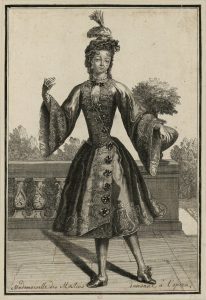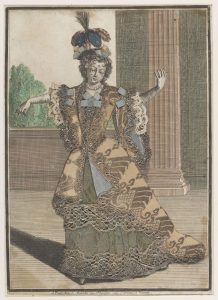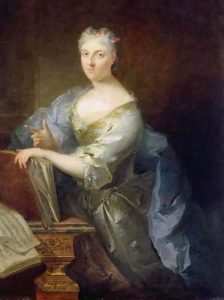Sausages for Breakfast:
Marie-Louise Desmatins in Hell

‘Mademoiselle des Mastins, dansant à l’Opéra’, Bibliothèque de l’Institut National d’Histoire de l’Art, collections Jacques Doucet.
Some writings begin with thoroughly decent intentions and this post is one of those, spirited into being by a rush of genial collegiality. Fellow haunter of the historical backstage, Sarah McCleave at Queen’s University Belfast, has recently uploaded the inaugural post for a new blog: Dance biographies: Female theatrical dancers circa 1680-1860. The very first piece is written by an esteemed colleague, Jennifer Thorp, on the dancer Marie-Thérèse Perdou de Subligny. And so, on the strength of this, I thought I’d reprise my own erstwhile scribblings on Subligny, giving a plug to my fellows in the process.
Alas, noble design was curdled by the fallibility of my memory. The piece I dug out was actually about Marie-Louise Desmatins, not Subligny. But what’s a little confusion about colleagues between colleagues? And why should you not wish to hear about Desmatins from me, before clicking to ogle Subligny’s feet with Jennifer?
So let us to business. Let us lean back into the time vortex and gently fall towards the glorious excesses of Louis XIV, pausing to give a brief wave to 2010 when Darren Aronofsky unleashed his psychological horror film, Black Swan, upon the indignant and excitable among tutu-lovers. I took Aronofsky’s thriller as my cue to offer another kind of gory, fetishizing tale of ballet, celebrity and distorted self-image to the readership of Dance Australia.1 True, the year of 1711 might not instantly inspire your firmest expectations of schlock-horror. But if you’ve ever wandered down the darkened alleyways of French clandestine literature, you’ll know there’s no deed, no act, no delicious outrage left untapped by the radical political satirists of Louis XIV’s France.
First things first. Greet, if you will, Marie-Louise Desmatins (above), who appears in this splendid engraving c.1680-90s. The image is one of a number depicting artists of the Paris Opera in the highly-ornamented costume of their era. The illustrations catered to purchasers’ curiosity about the customs, habits and dress of celebrities or distinctive peoples, often selling alongside pictures of historical characters, exotic foreigners or allegorical figures. And let me elaborate on these prints for just a moment longer, so that Subligny might yet poke a toe into our story. Alison Dolan’s fascinating article on an “adorned print” in the Victorian and Albert Museum reveals that, while images could be displayed as decorative objects in their own right, they could also used by purchasers for domestic art and craft activities. 2 The English diarist Samuel Pepys, for instance, bought some for his wife “to draw by” during the long winter months (she was perhaps copying or colouring them). The subject of the V&A’s remarkable ‘adorned print’ is, yes, Marie-Thérèse Perdou de Subligny, the engraving that depicts her embellished with scraps of brocaded silk, ribbon and metal lace.
So, back to Marie-Louise Desmatins. Desmatins, like most of her contemporaries, is an elusive figure in the historical record, and she is generally accounted a singer, in fact, rather than a dancer. She was the daughter of the court violinist, Claude Desmatins, and the niece of the famous ballet master, Pierre Beauchamp (best remembered as the chap who codified ballet’s five basic positions of the feet).3 Beauchamp was, of course, also a feted choreographer of court entertainments, and the personal dancing-master and confidante of Louis XIV. Marie-Louise grew up within this sumptuous, regal atmosphere of music and theatre, making her debut at the age of 12 in the premiere of Jean-Baptiste Lully’s opera, Persée (1682). As Rebecca Harris-Warrick notes, “Only occasionally was a performer good enough at singing and dancing to be hired to do both.” Desmatins appears in librettos as a dancer and singer until 1703; “thereafter until her death in 1708, she sang only.” 4
Presumably, one of Marie-Louise’s most memorable roles was danced en travesti, for our engraving appears to show her wearing a man’s knee-length coat. Travesti, or cross-casting, was a feature of ballet from its earliest days as a court entertainment, and in Desmatins’ time it reflected the quintessentially baroque interest in spectacular optics, inversion and masquerade. Court ballets initially included men cross-cast as women with some regularity, until the number of professional female dancers increased after 1690. Marie-Louise may be an early example of a woman cross-cast as a man, but she was far from the last. Throughout the 1700s, women sporadically performed en travesti to showcase their dramatic range, promote special performances or act out narratives of disguise and romantic entanglement. The practice endured – teasing, subversive and, in the nineteenth century, often overtly sexual – until the opening decades of the twentieth century.
And thus we come to Marie-Louise’s appearance in the scandalous and obscure novel, La Musique du Diable (The Devil’s Music, 1711). Brought to our attention by Greek-American musicologist, Ilias Chrissochoidis, the novel is set in Hell and tells of Desmatins’ adventures in the Underworld.5 Marie-Louise, charming and charismatic, arrives at the gates of Hell where she is accused of a litany of misdeeds including bankrupting respectable businessmen, prostitution, attempted assassination, poisonings, having abortions and general megalomania. However, her most sensational misdeed is that relayed as her cause of death. In a bid to lose weight, Marie-Louise, so the fiction goes, has “eight to ten pounds of fat removed … by one of the best surgeons in Paris.” A truly macabre tale follows, for Desmatins proceeds to amuse herself by secretly feeding her cut-off fat to friends. She has a local butcher prepare “fine saveloys, puddings [and] sausages” which she feeds “to anyone that her fancy picked” including her lovers and the Royal Treasurer. Inevitably her rudimentary liposuction backfires and she finally dies six weeks later.
Is there any truth to this story? Well, a contemporary source does hint that “a little plumpness” eventually spoiled Desmatins’ “tall and shapely” figure, though her probable cause of death has been given as a liver ulcer.6 But La Musique du Diable is no more concerned with fact than Aronofsky’s Black Swan is with docu-drama realism. It is, like other scandalous texts of its era, chiefly intended to titillate while focusing anxieties about the authority of the French crown. In an era when political attacks on the monarchy were treasonable, it was far safer for satirists to direct their barbs against what the French elite loved best: the opera and ballet. Desmatins’ infernal escapades are a reminder of the apprehensions and desires that so frequently underpin ballet’s representation in political and popular culture. Three hundred years later, we have Aronofsky’s film to show that ballet retains its perennial appeal as a hallucinatory world of neurosis, sex and gore!
- This article, republished here with revisions, originally appeared as “Marie-Louise Desmatins c.1670-1708: The ‘Black Swan’ of the 17th Century”, Dance Australia, Issue 176, Oct-Nov 2011, 63. ↩
- Alice Dolan, ‘An adorned print: Print culture, female leisure and the dissemination of fashion in France and England, around 1660-1779’, V&A Online Journal, no. 3 (2011). ↩
- Nathalie Lecomte, “The Female Ballet Troupe of the Paris Opera from 1700-1725” in Lynn Brooks, ed. Women’s Work: Making Dance in Europe Before 1800 (Madison: University of Wisconsin Press, 2007), 104. ↩
- Rebecca Harris-Warrick , Dance and Drama in French Baroque Opera: A History (Cambridge: Cambridge University Press, 2016), 36. ↩
- Ilias Chrissochoidis, “La Musique du Diable (1711)”, Society for Eighteenth-Century Music Newsletter 11 (October 2007), 7–9. ↩
- Parfaict and Parfaict, “Histoire de l’Académie Royale de Musique,” quoted in Lecomte, 104-05. ↩



Leave a Reply